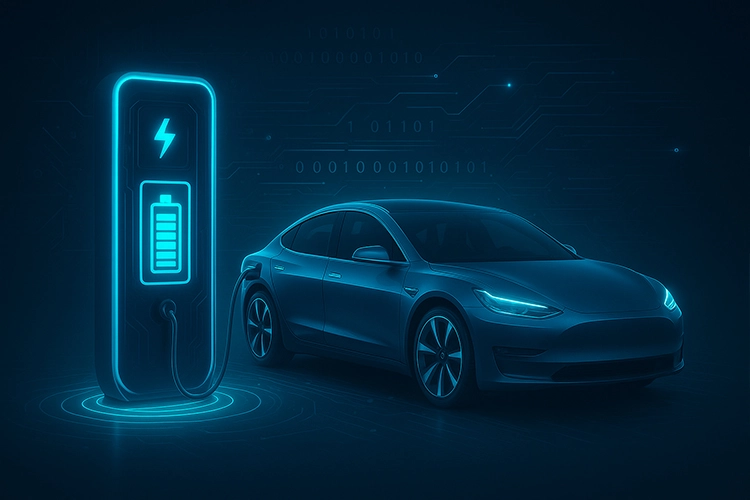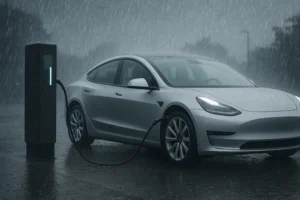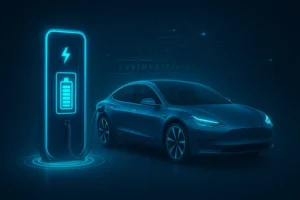Introduction
As electric vehicles (EVs) become more advanced, so does the technology that powers them. One of the most exciting innovations in EV infrastructure is the bidirectional EV charger. Unlike traditional chargers that only deliver power to the car, a bidirectional charger enables two-way energy flow—charging the EV battery and sending electricity back to the grid or home. This transforms EVs into mobile energy storage units, creating new possibilities for energy management.
1.What Is a Bidirectional EV Charger?
A bidirectional EV charger is an advanced charging station that allows energy to move both into the EV (charging) and out of the EV (discharging). This technology supports Vehicle-to-Grid (V2G), Vehicle-to-Home (V2H), and Vehicle-to-Load (V2L) applications.
The most critical component in the design of a bidirectional charging station is the two-way AC/DC current conversion module.
The AC/DC power supply utilizes three-level technology for bidirectional AC/DC conversion. The DC/DC portion employs high-frequency isolated DC bidirectional conversion technology, also known as soft-switching resonant technology, for high efficiency. The converter also provides bidirectional energy flow and automatic switching between charge and discharge. A dual DSP design ensures stable AC/DC and DC/DC performance, supports parallel connection of modules, and supports CAN communication, facilitating communication and control with third-party devices.
This module’s capabilities enable the bidirectional charging station (V2G/V2H/V2L) functionality.
Key Functions:
V2G (Vehicle-to-Grid): EV batteries supply power back to the grid during peak demand.
V2H (Vehicle-to-Home): Use your EV as backup power for your house during outages.
V2L (Vehicle-to-Load): Power small appliances, tools, or devices directly from your EV.

2.Benefits of Bidirectional EV Chargers
Energy Cost Savings
Charge during off-peak hours when electricity is cheaper, then feed power back during peak hours.Emergency Power Backup
Provide electricity to homes and businesses during blackouts or grid failures.Support for Renewable Energy
Integrates with solar panels and home energy storage systems to maximize self-consumption.Grid Stabilization
Helps balance demand and supply, reducing stress on local electricity networks.Revenue Generation
EV owners and businesses can participate in energy trading programs by selling excess power back to utilities.
3.Applications of Bidirectional EV Chargers
Residential Homes: Power your house at night with stored EV energy.
Commercial Properties: Reduce peak energy bills by using EV fleets as backup storage.
Fleet Operators: Create large-scale mobile energy storage to support business operations.
Renewable Energy Projects: Combine with solar EV charging for maximum efficiency.

4.Bidirectional vs. Traditional EV Chargers
| Bidirectional vs. Traditional EV Chargers | ||
| Feature | Traditional EV Charger | Bidirectional EV Charger |
| Power Flow | One-way (grid → EV) | Two-way (grid ↔ EV) |
| Energy Backup | No | Yes, supports V2H and V2L |
| Grid Services | None | Supports V2G programs |
| Cost Efficiency | Standard electricity use | Potential energy savings & revenue |
| Integration with Solar | Limited | Full integration with renewable systems |
Consider bidirectional EV chargers from two perspectives.
On the one hand, they can enable electric vehicles to charge and discharge simultaneously, demonstrating the versatility of battery energy storage.
As the number of electric vehicles increases, it’s predicted that there will be 80 million electric vehicles on the road by 2030. This massive number of electric vehicles can serve as both flexible loads on the user side and distributed power generation equipment, helping to regulate grid load, shift peaks and fill valleys, absorb renewable energy, and provide auxiliary services such as frequency regulation and backup, thereby reducing distribution network investment.
This EV energy storage V2G is a bidirectional DC charging station that can both charge and discharge, with a maximum power of 250kW, meeting the power requirements of most current DC charging stations. This allows for two-way energy flow between electric vehicles and the grid, enabling electric vehicles to charge at low-cost, off-peak electricity and discharge during peak hours, allowing owners to profit from the difference in electricity costs. This improves load flexibility, reduces distribution network investment, and absorbs clean energy. It also boosts the development of the electric vehicle industry and reduces the land occupied by public charging facilities.
The difference in peak and off-peak electricity prices can enable free electricity use or even profit.
On the other hand, will this shorten the lifespan of electric vehicle batteries? Most people favor bidirectional EV chargers for profit, only mentioning the good stuff. However, to truly consider the overall logic, we need to consider battery life and replacement costs.
Lithium-ion batteries can have a service life of approximately 2,000 complete cycles, but this figure is still relatively theoretical or ideal. Each charge causes a slight decrease in capacity, so with continued V2G operation, the battery life decreases linearly.
Referring to the national standard GB/T-31484, the actual requirement is that the capacity of a power battery should decrease by no less than 80% of its initial capacity after 1,000 charge and discharge cycles.
Based on a 20% reduction after 1,000 charge and discharge cycles, the vehicle’s convenience would have been compromised by then, and it would be time to replace the battery. However, if the V2G model is truly profitable, most car owners will frequently charge and discharge the battery. Based on an average of 300 charge and discharge cycles per year, should the vehicle’s power battery need to be replaced within four years? During this phase, battery replacements can be done through warranty channels, but automakers won’t shoulder this burden. It’s foreseeable that as V2G becomes widespread, automakers will limit the frequency and quantity of electricity sales, lest they lose their warranties.
If one were to replace the battery out of pocket, even if they could generate five-figure revenue annually from electricity sales, it would still be far from covering the cost of replacement.
In fact, the V2G model tests the lifespan of power batteries; theoretical data should only be used as a guide. Actual battery lifespans will likely vary significantly under different environmental factors and vehicle operating conditions. Furthermore, the replacement cost of power batteries, even lithium iron phosphate batteries, remains relatively high, so we need to carefully consider whether this is reasonable.
But we believe that Bidirectional EV Charger will have a larger market in the future, as energy demand is the foundation of our lives.
Bidirectional EV charging is more than just a trend—it is the foundation of the next generation of smart grids. As EV adoption rises, the ability to use cars as energy storage systems will redefine how homes, businesses, and cities manage electricity. Investing in bidirectional EV chargers today positions you at the forefront of this transformation.

Anengjienergy Bidirectional EV Charger Solutions
At Anengjienergy, we provide next-generation bidirectional EV chargers designed for both residential and commercial applications.
Our Solutions Include:
AC Bidirectional Chargers: Ideal for home use with smart energy management.
DC Fast Bidirectional Chargers: 120kW-720KW EV Charger solutions for fleets and commercial sites.
V2G-Ready Systems: Compliant with international standards and OCPP protocols.
Integration with Solar + Storage: Turn EVs into part of a complete renewable energy ecosystem.
Custom Branding & OEM/ODM: Tailored hardware and software to meet client needs.
With operations in Europe, South America, Asia, the Middle East, Russia, and Central Asia, we deliver turnkey solutions that future-proof your EV infrastructure.



